Beyond mere coincidence, the number 120 in the Bible holds secrets to pivotal historical and spiritual moments—discover its profound significance.

120 in the Bible
It's as if the number 120 has a secret life of its own within the pages of the Bible, appearing at moments that have shaped the course of history. You'll find it marking the lifespan of Moses, echoing through the gathering at Sinai, detailing Solomon's workforce, numbering the priests, and even in the upper room assembly.
This isn't just a coincidence; it's a pattern that begs for a deeper exploration. What could this number signify, and why does it recur across such pivotal events? Let's embark on a journey to uncover the mysteries wrapped around the number 120, a quest that promises to reveal insights into the biblical narrative and its profound implications for understanding history and faith.
Key Takeaways
- The number 120 symbolizes completion and transition, as seen in Moses' 120-year lifespan and leadership.
- Divine encounters, like the Gathering at Sinai, solidify community faith and covenant with God.
- Solomon's innovative leadership and temple construction methods highlight the importance of wisdom in governance.
- The early Christian community's transformation, marked by events like the Pentecost, underscores the role of the Holy Spirit in communal empowerment.
The Lifespan of Moses

Moses, a seminal figure in Abrahamic religions, lived to the ripe age of 120 years, a lifespan that carries significant theological and symbolic implications within the biblical narrative. You're diving into an analysis that not only explores the longevity of Moses but also how his extended years reflect upon his leadership and the period of desert wanderings he guided the Israelites through.
Moses' leadership wasn't merely a role but a testament to his resilience, wisdom, and unwavering faith. His age, at the time of his death, isn't just a number; it symbolizes the completion of a divine mission, marking the end of an era and the beginning of a new covenant. You'll find that his journey, especially the desert wanderings, serves as a powerful metaphor for spiritual purification and preparation. Moses led his people through the wilderness for 40 years, a period fraught with challenges and lessons that shaped the Israelite community's identity and faith.
Through these wanderings, Moses' character was forged in the harshness of the desert, embodying patience, leadership, and a deep connection to the divine. This period under Moses' guidance was crucial for the Israelites to transform from a group of escaped slaves into a nation ready to enter the Promised Land.
Your analysis reveals that Moses' 120 years weren't just about longevity but were intricately linked to his mission and leadership. His life encapsulates a journey of faith, leadership, and divine purpose, making his age at death profoundly symbolic within the biblical context.
The Gathering at Sinai
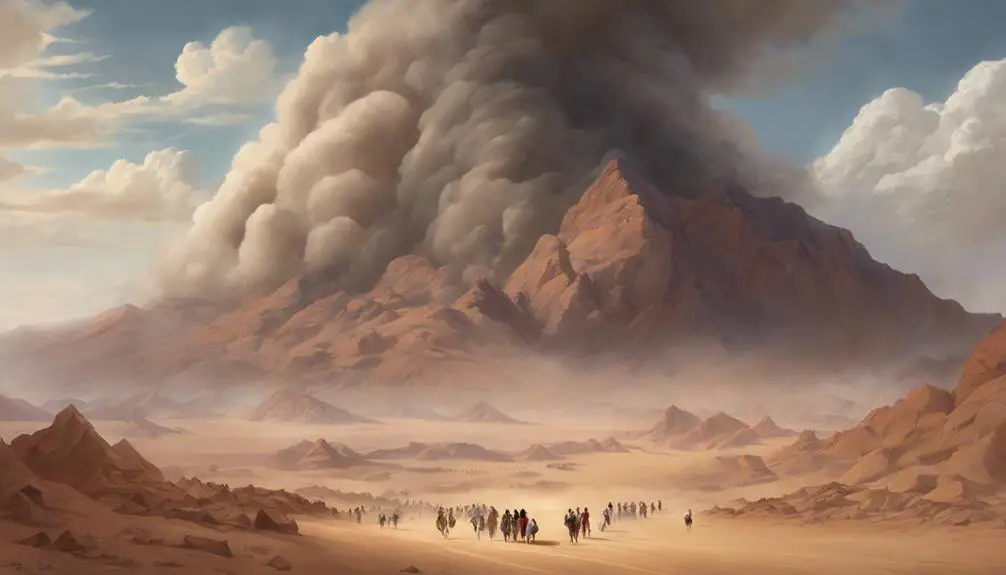
At the heart of the desert, amidst the tumult of wandering, the Israelites' gathering at Sinai stands as a pivotal moment in their spiritual and communal development. This sacred location becomes the backdrop for a dramatic covenant renewal, marking a transformation in their relationship with the divine. You're witnessing a foundational episode, where the collective identity of the Israelites is both formed and affirmed.
To create a vivid image of this moment, consider the following:
- The stark, imposing mountain of Sinai, rising abruptly from the desert floor, symbolizing both the majesty and the unapproachable nature of the divine.
- The encampment of a multitude, gathered in awe, their faces turned towards the mountain, awaiting the profound revelation with a sense of anticipation and reverence.
- The thunder and lightning, signifying the divine presence, enveloping the mountain in a shroud of mystery and power, instilling both fear and fascination.
- Moses ascending Sinai, acting as the intermediary between the divine and his people, his figure a bridge between the earthly and the heavenly, the human and the divine.
This gathering at Sinai isn't just a historical or spiritual anecdote; it's a pivotal event that underscores the importance of covenant renewal in maintaining the community's faith and identity. The detailed rituals, the setting apart of a sacred location, and the establishment of a set of laws not only create a code of conduct but also serve to unify the people under a shared belief system and divine mission.
The narrative at Sinai encapsulates a moment of both divine revelation and covenant formation, underscoring the intricate relationship between place, identity, and faith in the Israelites' journey.
Solomon's Workforce
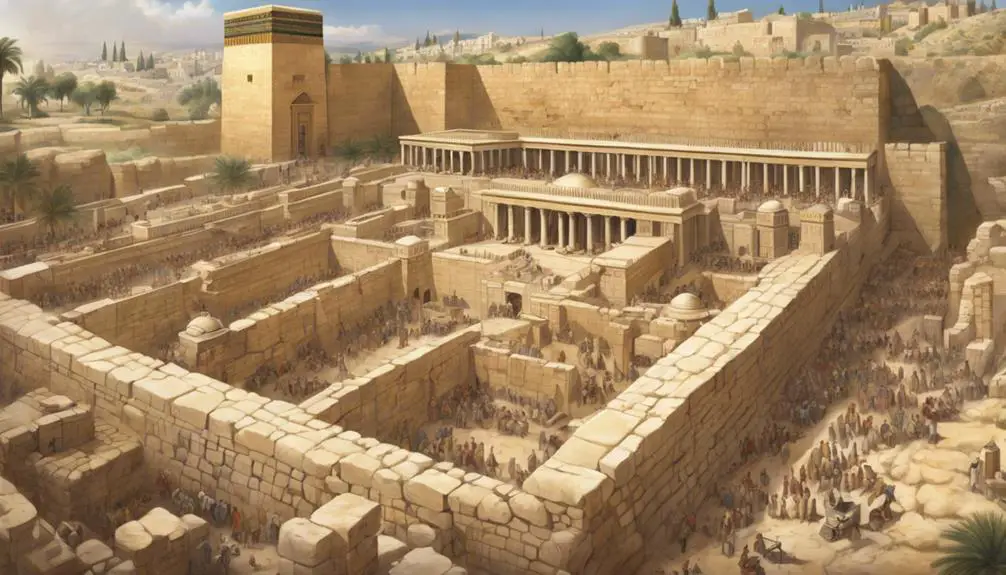
Solomon's workforce, a meticulously organized assembly, was instrumental in realizing his ambitious architectural and administrative projects, reflecting both the sophistication of his reign and the complexities of labor and resource management in ancient Israel. You must understand that this organization wasn't merely about manpower but also showcased Solomon's wisdom in governance and construction. This wisdom allowed him to marshal a vast number of workers, segregating them into specialized teams for efficiency and effectiveness in building methods.
The construction of the Temple, Solomon's most celebrated project, serves as a prime example of his innovative approach to labor and project management. Utilizing a workforce that included thousands of laborers, craftsmen, and overseers, Solomon implemented a systematic approach to construction that was ahead of its time. This method ensured that every aspect of the project, from the quarrying of stones to the intricate carving of wooden panels, was executed with precision and according to a well-orchestrated plan.
Analyzing Solomon's building methods further, you'll notice his strategic use of resources and alliances to supplement his workforce. By engaging in trade and labor agreements with neighboring kingdoms, he secured the materials and skilled artisans necessary for his projects. This not only demonstrates his diplomatic acumen but also highlights how his wisdom extended beyond the borders of Israel, influencing and leveraging international relationships for the benefit of his construction endeavors.
The Number of Priests
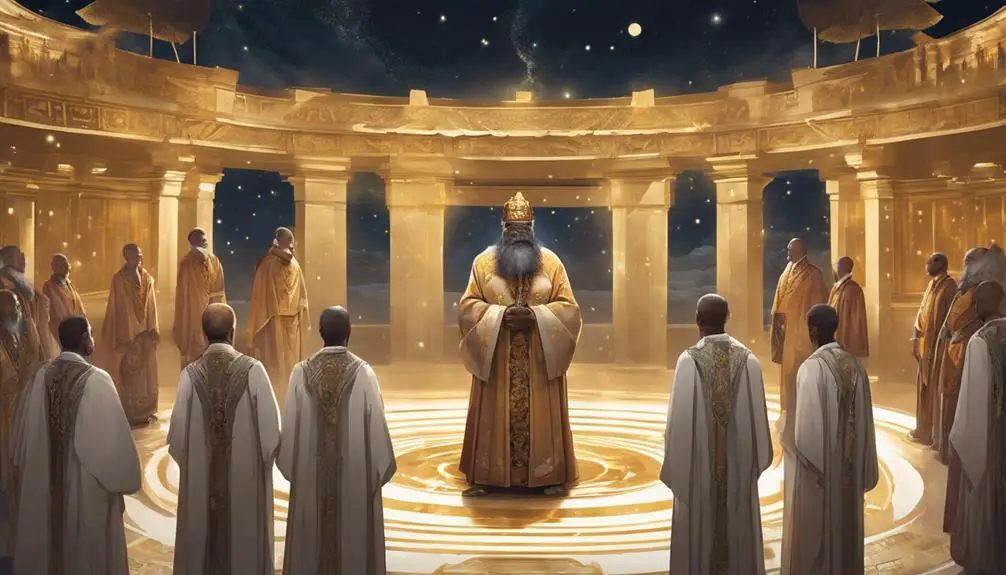
While Solomon's workforce played a crucial role in the physical construction of the temple, it's equally important to examine the structured organization of the priesthood, which was essential for the spiritual functions and daily operations within this sacred space. The priesthood, adorned in priestly garments, wasn't just a mere group of individuals performing religious rites; they were a well-organized cadre, integral to the temple's sanctity and the community's spiritual well-being.
The meticulous organization of the priesthood can be highlighted through the following aspects:
- Priestly Garments: Symbolizing purity and divine selection, these garments weren't merely clothing but a visual testament to the sanctity of their office. Each piece, from the breastplate to the ephod, was imbued with significance, representing the priest's role as a mediator between God and His people.
- Levitical Duties: Beyond leading worship, the Levites performed a variety of roles, including teaching the laws, maintaining the temple, and conducting music for worship. Their duties were expansive, ensuring the spiritual and physical upkeep of the temple complex.
- Division of Labor: The priesthood was divided into courses, with each group assigned specific times of service. This rotation ensured that the temple was always attended to, reflecting a divine order in their service.
- Spiritual Leadership: Above all, the priests were spiritual leaders. They guided the community in worship, offered sacrifices, and sought to embody the holiness prescribed by their office.
The organization of the priesthood, through its hierarchical structure, priestly garments, and Levitical duties, was pivotal in maintaining the temple as a place of worship and spiritual encounter.
The Upper Room Assembly
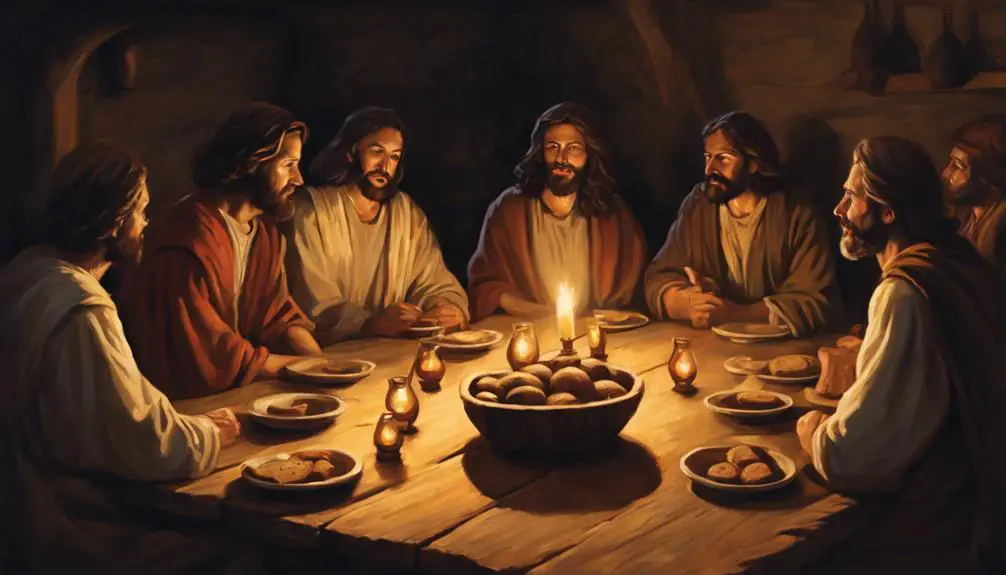
In the aftermath of the temple's completion, the Upper Room Assembly emerges as a pivotal moment, signifying a profound shift in the spiritual dynamics and communal worship practices of the time. This gathering, held in a modest upper room in Jerusalem, marks a critical juncture in the early Christian community, especially in the context of Pentecost's significance. You'll find that this assembly wasn't merely a routine gathering; it represented the fulfillment of Jesus' promise to send the Holy Spirit to his followers, thus empowering them for their global mission.
The Pentecost event, central to the Upper Room Assembly, underscores a transformative experience where the disciples received the Holy Spirit, enabling them to speak in various tongues. This miraculous manifestation symbolizes not only the divine endorsement of their mission but also the inauguration of a new covenant, distinct from the old, temple-centric worship. The disciples' unity, evident in their collective experience of the Holy Spirit, illustrates a key aspect of the assembly's significance. This unity transcends mere physical gathering; it encapsulates a spiritual harmony, fostering a communal identity rooted in a shared faith and purpose.
Analyzing the Upper Room Assembly, you'll recognize it as a foundational moment for Christian ecclesiology. Here, the early church's form and function are vividly illustrated, setting a precedent for future generations. The disciples' unity in the Upper Room, underpinned by the Pentecost significance, serves as a powerful testament to the transformative power of collective faith and the indwelling of the Holy Spirit, shaping the trajectory of Christian worship and community life henceforth.
Frequently Asked Questions
How Do the Concepts of Forgiveness and Redemption Manifest Throughout the Bible?
You're exploring how forgiveness and redemption are universal themes, deeply rooted in the notions of Divine Mercy and Sacrificial Love. These concepts aren't just central narratives; they reflect a profound understanding of human nature and morality.
Through acts of selfless love and mercy, redemption becomes attainable, highlighting the transformative power of forgiveness. This analysis shows how these themes, while abstract, are tangibly manifested through actions embodying sacrificial love and divine mercy.
What Role Do Dreams and Visions Play in Biblical Narratives and Their Significance?
In narratives, dreams and visions often serve as conduits for divine guidance, playing a crucial role. They're not just figments of imagination; they carry deep prophetic symbolism, offering insight and direction.
You'll find that these elements are pivotal for understanding the underlying messages and themes. They're meticulously crafted to communicate more than what's on the surface, guiding characters and, by extension, you, through their symbolic meanings and implications.
Can the Bible's Stance on Environmental Stewardship Be Elaborated Upon?
You're exploring how a text advocates for environmental stewardship, focusing on creation care and sustainable living.
It's essential to analyze the directives given for nurturing and preserving the environment. This involves dissecting principles of stewardship, responsibility towards nature, and promoting a lifestyle that ensures the well-being of the planet.
The guidance provided is critical for understanding how individuals are encouraged to interact with and protect the natural world, fostering a sustainable coexistence.
How Does the Bible Address Issues of Social Justice and Equality Among Different Communities?
Regarding social justice and equality among communities, it's essential to consider principles of prophetic advocacy and the ethos of 'love thy neighbor.'
These concepts drive the belief that everyone deserves respect and fair treatment, regardless of their background. Through prophetic advocacy, you're encouraged to speak out against injustices and work towards a more equitable society. Loving your neighbor means extending kindness and support to all, promoting unity and equality.
In What Ways Does the Bible Discuss Mental Health and Coping With Personal Struggles?
When exploring mental health and personal struggles, you'll find that emotional resilience and spiritual comfort are often intertwined. Like a beacon in the night, these concepts guide individuals through turbulent times.
Analytically, it's seen how narratives or teachings can bolster one's ability to cope, offering a blueprint for navigating life's challenges. Scholarly examination reveals a detailed approach to understanding and fostering mental well-being, emphasizing the importance of inner strength and support.
Conclusion
In conclusion, the biblical number 120 weaves through scripture like a golden thread, marking moments of divine transition and human leadership. From Moses' lifespan to the assembly in the Upper Room, this number signifies a period of preparation and change.
Analyzing its occurrences reveals a pattern of divine orchestration and human organization, underlining the meticulous detail within the biblical narrative. Each mention of 120 isn't merely a figure but a symbol, rich with theological and historical significance, embodying God's intricate design in guiding His people.


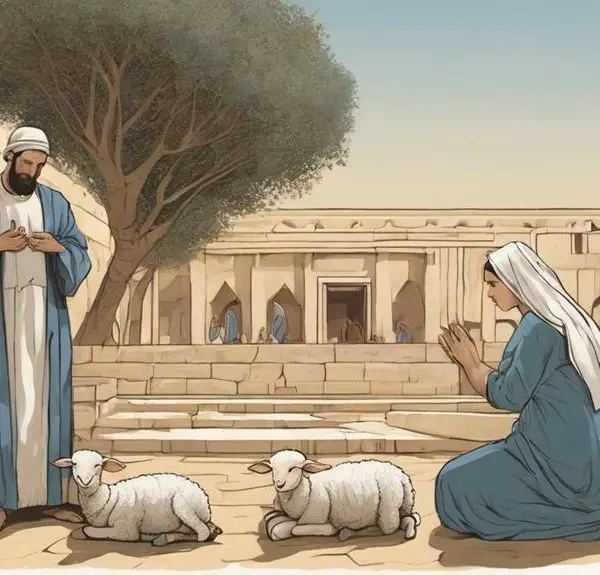
Sign up